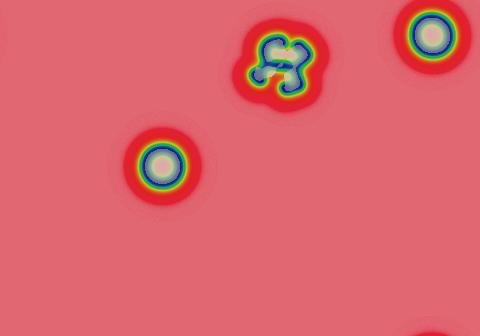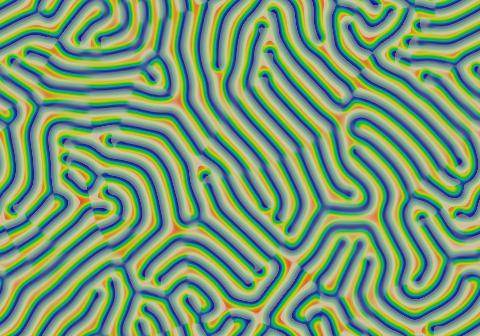Gray-Scott Model at F 0.0580, k 0.0630
These images and movie demonstrate the behavior of the Gray-Scott reaction-diffusion system with σ=Du/Dv=2 and parameters F=0.0580, k=0.0630.
Sufficiently symmetrical blue spots grow into regular loops that meander into clovers; less symmetrical spots become corals. Both types fill the space initially with loops and bends; once the space is full, worm tips prevail over bends. The system eventually attains maze or fingerprint appearance after 250,000 tu.
At F=0.0580, loops grow when k is about 0.0649 or less; above this k value (further east) they shrink to solitons.
Categories: Pearson κ; Wolfram 2-a (glossary of terms)
 increase F increase F
 | |||
 decrease k  |


|
15 frames/sec.; each fr. is 136 iter. steps = 68 tu; 1800 fr. total (122,400 tu) |  increase k 
|

|


| ||
 decrease F decrease F
 |
In these images:
- Color indicates level of u, ranging from purple (lowest u values) through blue, aqua, green, yellow and pink/red (highest u values)
- Areas where u is increasing are lightened to a light pastel tone; where u is decreasing the color is vivid.
- In areas where u is changing by less than ±3×10-6 per tu, an intermediate pastel color is seen. This includes areas that are in steady state or equilibrium.
''tu'' is the dimensionless unit of time, and ''lu'' the dimensionless unit of length, implicit in the equations that define the reaction-diffusion model. The grids for these simulations use Δx=1/143 lu and Δt=1/2 tu; the system is 3.2 lu wide. The simulation meets itself at the edges (periodic boundary condition); all images tile seamlessly if used as wallpaper.
Go back to Gray-Scott pattern index
This page was written in the "embarrassingly readable" markup language RHTF, and was last updated on 2019 Jan 05.
 s.11
s.11